|
It Happened in Jersey: Women's Sports
Double Trouble
Rutgers has fielded some inspiring and entertaining basketball teams over the years, but only one can claim a national championship. In 1981–82, the women’s team—led by twin sisters Patty and Mary Coyle—was one of 16 that competed in the Association 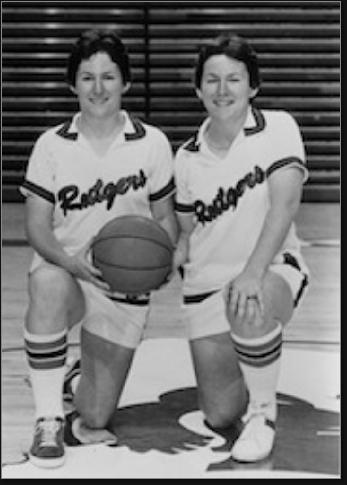 for Intercollegiate Athletics for Women (AIAW) tournament, which was held concurrently with the inaugural NCAA women’s tournament. The AIAW had been the pioneering organization for women’s hoops, holding tournaments throughout the 1970s. The 1982 competition would be its last. for Intercollegiate Athletics for Women (AIAW) tournament, which was held concurrently with the inaugural NCAA women’s tournament. The AIAW had been the pioneering organization for women’s hoops, holding tournaments throughout the 1970s. The 1982 competition would be its last.
Head coach Theresa Grentz guided the senior-heavy Lady Knights through the East Regional with victories over Georgia Southern and Minnesota to earn a berth in the Final Four in Philadelphia. The team’s high-scoring center, Terry Dorner, and Patty Coyle starred in the regional rounds, along with June Olkowski, one of the nation’s best players, who recovered from two knee injuries during the season.
In the Final Four, Rutgers edged tourney host Villanova 83–75 and upset Texas 83–77 in the final. Patty Coyle scored 30 in the title game and Dorner added 25, ending UT’s 32-game winning streak. Coyle was named the tournament’s Most Valuable Player. Mary Coyle picked apart the Longhorn’s vaunted full-court press and completed a three-point play in the second half—her only bucket of the game—that gave Rutgers a 59–57 lead the Lady Knights would not relinquish. Rutgers’ final record for 1981–82 was 25–7. One of those wins was a 91–69 wipeout of powerhouse UCLA, which gave the Lady Knights the confidence to outplay a team like Texas, which was more athletic and physical than Rutgers.
Patty Coyle went on to a successful college and pro coaching career. She was a member of Richie Adubato’s staff with the WNBA New York Liberty from 1999 to2004, when she replaced Adubato during the 2004 season. In 2008, the Liberty drafted Rutgers star Essence Carson and in 2009 they took Kia Vaughn. In 2009, Coyle was replaced mid-season by fellow New Jerseyan Anne Donovan. Coyle returned to the college ranks and coached St. Peter’s in Jersey City from 2013 to 2018. Mary Coyle enjoyed great success coaching Rutgers Prep. In 1993, the Coyle Twins were inducted into the Rutgers Athletic Hall of Fame. They were featured in the documentary Forgotten Champions.
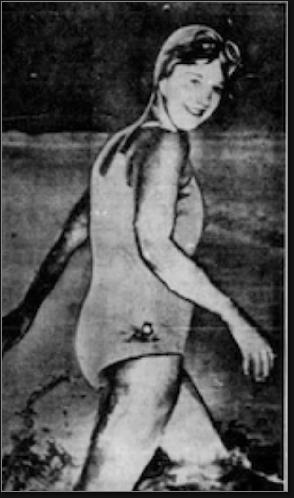 So what did you do So what did you do
in the 50s, Mom?
Marilyn Di Lascio was a beloved teacher for more than two decades in New Jersey and raised four children in the Garden State. Neither her students nor her own kids had an inkling that she was Marilyn Bell, the world-famous marathon swimmer. She just never bothered to mentioned that she had been the 1954 Canadian Newsmaker of the Year…or that she was the youngest person to complete the English Channel swim…or that she was the first person to swim from the US to Canada across Lake Ontario. The cat finally got out of the bag in 1993, when she was inducted into Canada’s Swimming Hall of Fame and was also feted as one of the country’s greatest athletes of the 20th century.
Ironically, it was in New Jersey where Marilyn Bell first found her way into the sports headlines.
One of the annual summer highlights of New Jersey sports in the 1950s and 60s was the annual Atlantic City “Around the Island” marathon swim—which circled Absecon Island and passed by AC, Ventnor, Margate and Longport. On July 26, 1954, Marilyn, 16, completed the 22.7-mile event in 10 hours, 7 minutes. Although she finished 7th, Marilyn was the first woman in history to complete the challenging race. She pocketed $1,150 for her 7th-place finish. The first- and second- place finishers in the race were also Canadian—teammates of Marilyn’s at the Lakeshore Swimming Club in Toronto.
This accomplishment launched Marilyn’s career as a long-distance swimmer. She went on to become the first swimmer, man or woman, to swim the 32 miles from the US to Canada across Lake Ontario later that summer, earning $10,000. She started in Youngstown, NY and finished in Toronto.
In 1955, Marilyn became the youngest person to swim the English Channel, and did so in 14 hours, 36 minutes. She was greeted by 100,000 fans when she returned to Toronto. After retiring from competitive swimming in 1957, Marilyn married Joe Di Lasci—an Atlantic City lifeguard she'd met while training for the 1954 swim—and moved from Canada to Willingboro, New Jersey, where she began her new career as a teacher.
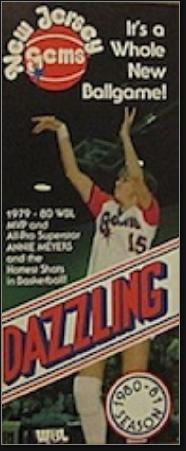 Dynamic Duo Dynamic Duo
Women’s hoops fans often wonder what might have happened had the two greatest college stars of the 1970s ever played on the same team. Imagination is a wonderful thing, however in this case it isn’t necessary. During the third (and final) season of the Women’s Professional Basketball League, 1980–81, Carol Blazejowski and Ann Meyers suited up for the New Jersey Gems, who played their home games in West Orange at what is now the Richard J. Cody Arena.
Meyers (right) had joined the Gems a season earlier, when they played in Elizabeth’s Dunn Center, leading the club to a 19–17 record and sharing league MVP honors with Molly Bolin of the Iowa Comets. Blazejowski (below) had been the league’s first draft pick in 1978, but turned down a pro contract so she could retain her eligibility for the 1980 Olympics. After the U.S. Boycott was announced, she signed a three-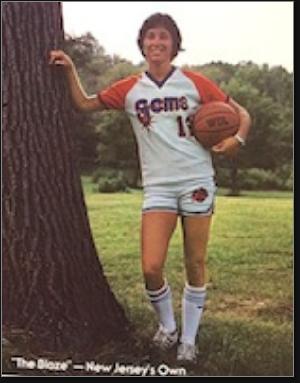 year deal with the Gems for $150,000. year deal with the Gems for $150,000.
Meyers and Blazejowsi teamed with Tara Heiss, also a member of the ill-fated Olympic squad, and Faye and Kaye Young, twin sisters who had played their first two pro seasons across the river with the New York Stars. Faye would become the coach at Manhattan College and Kaye married future NFL coach Bill Cowher. The Gems went 23–13, fashioning the third-best record in the league. They lost in the opening round of the playoffs to Nancy Liebermann and the first-place Dallas Diamonds, 2 games to 1. Kathy Mosolino coached the team in its final season; George Kennedy and Howie Landa coached the Gems in their first and second seasons, respectively.
During the 1980–81 campaign, Blazejowski scored 1,067 points—including a 53-point performance—for a 29.6 ppg average. She was one of only two players in WPBL history to reach quadruple-figures in a season. Prior to Blazejowski’s arrival, Meyers had been the league’s greatest drawing card, a triple-double threat almost every time she took the court. It was as a Gem that she developed a romance with Hall of Fame pitcher Don Drysdale, who was filming a feature on Myers for a Los Angeles TV station.
America’s boycott of the 1980 Summer Games in Moscow spelled doom for the WPBL. The plan from its inception was to bring all the gold medalists into the league for the start of its third season. With zero publicity for America’s top players, the WPBL failed to draw enough fans in 1980–81 to stay afloat, and the league disbanded.
Meet Me in Newark
The first AAU track & field championships were held in Newark in 1923. Held in Weequahic Park, it was exclusively a women’s event. The New Jersey venue was no coincidence. During the ’teens and 20s, the top female athletes in America competed for athletic clubs or teams sponsored by various businesses. One of the most successful track and field squads was the Athletic Association assembled by Prudential Insurance, which was headquartered in Newark. The 1923 AAU event was held on Saturday, September 29th.
Twelve different organizations sent athletes to Newark, including Prudential, the Newark Normal School, the Paterson recreation Department and the German-American Turnverein, all from New Jersey. Other clubs came from New York, Connecticut and Pennsylvania. Conspicuous by their absence were local college track squads. Women’s track programs had been all but non-existent in the previous decade, and would not 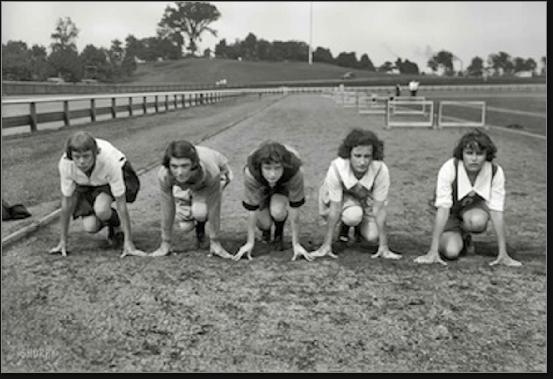 begin producing world-class athletes until after World War II. Most of the competitors in Weequahic Park were, or had been, high-school stars. begin producing world-class athletes until after World War II. Most of the competitors in Weequahic Park were, or had been, high-school stars.
The meet involved 11 events: High Jump, 50- and 100-Yard Dash, 60-Yard Hurdles, Running Broad Jump, Shot Put, Discus, Javelin, Baseball and Basketball Throw, and 440-Yard Relay. The new AAU rules for women limited competitors to three events, outlawed stretching or massage between events, and dictated a dress code of bloomers or loose, knee-length running shorts. Women also had to wear a bra and a running shirt with quarter-length sleeves—no tank tops.
Marion McCartie, who ran for the City Bank team in New York, won the 50-yard dash in 6.6 seconds. The 100-yard dash went to Frances Ruppert of Philadelphia’s Meadowbrook Club in 12 seconds flat. Ruppert’s time tied the American record, which was set by three other women in the qualifying and semifinal rounds.
Prudential’s Hazel Kirk edged teammate Esther Bering in the hurdles, which were held on grass instead of the park’s cinder track. Thus Kirk’s time of 9.6 seconds established a new national record (on grass). Behring won the basketball throw with a toss of 87’6”, defeating Eleanor Churchill of the Robinson Female Seminary, which was part of Phillips Exeter Academy in New Hampshire. Churchill won the baseball throw with a distance of 234’5.75”.
Helen Dinnehey of Philadelphia’s Shanahan Country Club won the long jump at 15’4”. Catherine Wright of the Bridgeport Athletic Club won the high jump, clearing the bar at 4’7.5”. Babe Wolpert, a Newark resident who entered the meet on her own, won the discus at 71’9.5”—almost a foot farther than Ranck. Ranck finished first in the javelin with a throw of 59’7.75”. Berta Christophel, a Newark Turverein member, heaved the shot put 30’10.5”, almost a foot farther than Roberta Ranck, a Philadelphia “turner.” The Meadowbrook Club took relay honors with a record time of 52.4 seconds. The team consisted of Ruppert, Dorothy Bough, Grace Rittler and Madeline Adams.
The hometown Prudential A.A. team won the meet with 22 points, followed by the Meadowbrook Club with 19 and the Philadelphia Turgemeinde with 17.
|
|
|